Push-pull configuration: Difference between revisions
Bot: Removing Commons:File:Cessna 337 Skymaster.jpg (en). It was deleted on Commons by INeverCry (Per Commons:Commons:Deletion requests/Files in Category:Cessna 337). |
|||
| Line 16: | Line 16: | ||
==Design problems== |
==Design problems== |
||
The rear engine operates in the disturbed air from the forward engine, which reduces its efficiency to around 70% of the forward engine. In addition the rear engine can interfere with the aircraft's rotation during takeoff if installed in the tail, or they require additional |
The rear engine operates in the disturbed air from the forward engine, which reduces its efficiency to around 70% of the forward engine. In addition the rear engine can interfere with the aircraft's rotation during takeoff if installed in the tail, or they require additional compromise to be made to ensure clearance. This is why they are more common on seaplanes, where this is not a concern. |
||
==Piloting== |
==Piloting== |
||
Revision as of 16:12, 14 January 2015
An aircraft constructed with a push-pull configuration has a mixture of forward-mounted (tractor) propellers and backward-mounted (pusher) propellers.
Historical
An early example of a "push-pull" aircraft was the Short Tandem Twin: another was the Caproni Ca.1 of 1914 which had two wing-mounted tractor propellers and one centre-mounted pusher propeller. Around 450 of these and their successor, the Ca.3 were built. One of the first to employ two engines on a common axis (tandem push-pull) was the one-off, ill-fated Siemens-Schuckert DDr.I fighter of 1917.
Claudius Dornier embraced the concept, many of his flying boats using variations of the tandem "push-pull" engine layout, including the 1922 Dornier Wal, the 1929 Dornier Do X and the 1938 Dornier Do 26. A number of Farmans and Fokkers also had push-pull engine installations, such as the Farman F.121 Jabiru and Fokker F.32.
Configuration
Push-pull designs have the engines mounted above the wing as Dornier flying boats or more commonly on a shorter fuselage than conventional one, as for Rutan Defiant or Voyager canard designs. Twin boomers such as the Cessna Skymaster and Adam A500 have the aircraft's tail suspended via twin booms behind the pusher propeller. In contrast, both the World War II-era Dornier Do 335 and the early 1960s-designed French Moynet M 360 Jupiter experimental private plane had their pusher propeller behind the tail.
Design benefits
While pure pushers decreased in popularity during the First World War, the push-pull configuration has continued to be used. The advantage it provides is the ability to mount two propellers on the aircraft's centreline, thereby avoiding the increased drag that comes with twin wing-mounted engines. It is also easier to fly if one of the two engines fails, as the thrust provided by the remaining engine stays in the centerline. In contrast, a conventional twin-engine aircraft will yaw in the direction of the failed engine and become uncontrollable below a certain airspeed, known as VMC.
Design problems
The rear engine operates in the disturbed air from the forward engine, which reduces its efficiency to around 70% of the forward engine. In addition the rear engine can interfere with the aircraft's rotation during takeoff if installed in the tail, or they require additional compromise to be made to ensure clearance. This is why they are more common on seaplanes, where this is not a concern.
Piloting
Pilots in the United States who obtain a multi-engine rating in an aircraft with this push-pull, or "centerline thrust," configuration are restricted to flying centerline-thrust aircraft; pilots who obtain a multi-engine rating in conventional twin-engine aircraft do not have a similar limitation with regard to centerline-thrust aircraft.[citation needed]
Military application

Despite its distinct advantages push-pull configurations are rare in military aircraft. This is mainly due to the increased risk to the pilot in the case of a crash-landing or the need to parachute from the plane. In a crash the rear engine threatens to kill the pilot by crushing him between itself and the forward engine; in the case of bailing-out the pilot is in danger of hitting the rear propeller. Examples of past military applications include the late WWII Dornier Do 335 heavy fighter, which included explosive charges to jettison the rear propeller and ejection seat to facilitate bailing out, and the Cessna O-2, a militarised version of the Skymaster used for observation and forward air control during the Vietnam war.
Images
External links
- Star Kraft SK-700 - 2 x 350hp 1000aircraftphotos.com



